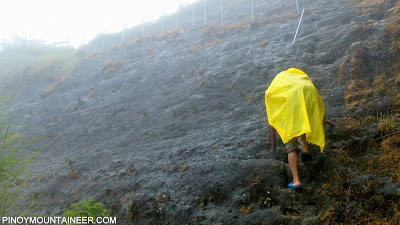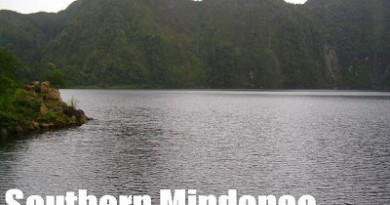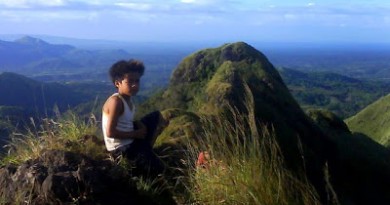Hiking advice: Eight pointers for hiking in the rainy season
PinoyMountaineer.com
HO CHI MINH CITY – Climbing season 2011 is over, and while off-season hiking in the Philippines can be a great experience, and with luck, you can even get a good sunrise view atop Mt. Pulag or elsewhere, we are encouraging hikers to be extra-careful when climbing in the next four months. Last week, we received two reports of hikers requiring rescue, in Mt. Talinis and Mt. Matutum. Also worth noting: the two most recent hiking-related deaths in the country happened in the rainy season, because of rivers and heavy rains.
Thus, there is a need to be extra-careful. Here are some specific pointers for hiking in the rainy season:
1. An upcoming typhoon is definitely a valid reason for cancelling a climb. This principle, of course, must be taken on a case-to-case basis:a typhoon somewhere up north, even if it’s signal #3, might not have much impact on a Mt. Maculot dayhike. But I believe it is better to err in the side of safety, especially with major cimbs, and I strongly advise hikers to reconsider their plans if there’s a typhoon coming on the very day of their climb.
2. After a recent typhoon, double-check the status of the roads and trails. Even if a typhoon has already passed, it can still have an impact on your climb. It can sometimes make roads inaccessible, especially in the Cordilleras. Sometimes, Mt. Pulag, Bakun Trio, and Mt. Amuyao become inaccessible because of landslides due to a recent typhoon, or even just continuous heavy rains. It is best to check with your contacts before before proceeding. Moreover, “easy-to-find” trails can become very confusing if typhoons erode parts of it. After typhoon ‘Milenyo’, I had a hard time retracing the trails of Mt. Makiling, and a 3-hour climb took five hours – even if I had climbed the mountain over a dozen times.
3. Adjust the itinerary. Because of the things mentioned in #2, and because of other delays due to rain, hikers must tweak their itinerary a bit to account for delays, slower pace, among others.
4. Bring a rope. This is especially true for mountains with known river crossings; but even in mountains without, trails can become rivers, trails can be eroded and suddenly become steep, so bringing a rope for me is a very important safety precaution.
5. Brace for more mud and more limatiks. The right mindset for a rainy climb is to be prepared for muddy (and slippery trails), limatik-infested trails, and many other ‘inconveniences’ or ‘adventures’. All these are not really hazardous; they are more of nuisances and can easily be overcome as long as you are up for it.
6. Waterproofing is nice, but celebrating rain is also nice. When climbing in the rain, you can surround yourself with Gore-TEX gear and remain dry, even though some hikers like Andrew Skurka say that there’s no such thing as fully waterproof-breathable gear. A cheaper alternative is to welcome rain, and enjoy it! As long as your valuables are secure, and as long as there are no dangerous parts in the trail, hiking in the rain can be fun.
7. Listen to your guide. This is very important. If guides themselves are doubtful about the trail, believe them. I experienced this just a week ago, in Mt. Thumbpeak (Hiking matters #180). Jo Steven and I were eager to reach the campsite, but our guide advised against it, saying that the river cannot be crossed. Instead, we e-camped before the riverbank, and successfully reached the summit the next day. Listen to them with an open mind, so that they can freely say what their opinion is (of course, they’ll try to please the guests as much as they can).
8. Don’t be afraid to cancel or abort a climb. A good hiker not only knows how to go up, but when to go down, or when not to go up at all. I would give more credit to someone who cancelled a climb because of a typhoon, than to someone who climbed in spite of it. If the weather looks bad, before or even during a climb, the expedition leader must have the courage to call it off. Don’t believe that pressing on in a climb in spite of bad weather is an act of bravery. Sometimes, it takes more courage to cancel a climb than to continue it.
Having said thus, good luck to everyone who will be climbing in the coming weeks and months!
Updated June 11, 2012 in Makati City
RELATED HIKING ADVICE





Leave a Reply
9 Comments on "Hiking advice: Eight pointers for hiking in the rainy season"
9. Bring a Rain Coat/ Umbrella. Hiking in the rain can be fun. Being "rain-soaked" for a prolong period can be deadly. Keep yourself as dry as possible.
Thank your for sharing your insights , concern and unconditional love to Filipino mountaineers… bayani ka doc!
in the coming weeks or months may be considered rainy season but throughout the year and the country there are ALWAYS chances of rain. so your expensive imported waterproof gear may at many times fail. so instead of fighting water, consider local products that work with the rain and rivers. keywords; quickdry and drainage
Bringing a rope for assisted river crossings is a start, but you need to know how to use it. A rope improperly deployed is a serious hazard. Never put a rope straight across moving water and expect people to cross using it for support… and that's just a start.
Great tips! I really, really have reservations climbing during rainy season, after my stormy experience at Mt. Pulag. And that climb was in January with no typhoon forecasts. It's better to be safe. It's a different environment up there, especially during typhoons.